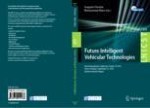2017 | Book
Future Intelligent Vehicular Technologies
First International Conference, Future 5V 2016, Porto, Portugal, September 15, 2016, Revised Selected Papers
Editors: Prof. Joaquim Ferreira, Dr. Muhammad Alam
Publisher: Springer International Publishing
Book Series : Lecture Notes of the Institute for Computer Sciences, Social Informatics and Telecommunications Engineering
